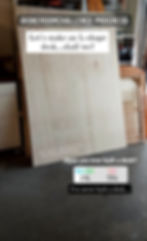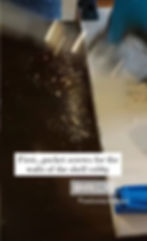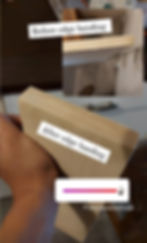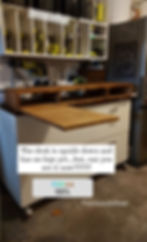DIY Modern Corner Desk
- Stephanie Lidin
- Nov 24, 2021
- 6 min read
I have never built a desk before...but, this is one of those times where it's harder to find a specific piece of furniture to fit the space. And let's be honest, even a mediocre brand new L shape desk is $350+, add in broken supply chains and delayed shipping. A new desk wasn't an option. Was I worried if this desk was going to turn out like crap? Um yes....but, to mitigate that worry...I researched a lot of desks. Watched YouTube videos on different builds and best ways to brace to add stability. And at this point, I was like...I don't have time to overthink this...the 8 week One Room Challenge deadline was looming.
Let's Skip to the Good Part
(Always a good idea so that you don't have to read ahead if you don't want to...haha)

The End Result
Honestly, I am proud of how well it turned out. It's sturdy as hell...has a slim profile and meets the size requirements of the space. Also, the fact that it is both a desk and a nightstand makes me happy it hits the functionality mark.
Supplies:
- 4x8 Aspen Plywood (saws I used: Mitre saw, Circular Saw, Table Saw...) You will have leftovers
- Birch Edgebanding (you need an iron for this)
- KregJig Mini Pocket Hole Jig (1.25" pocket screws)
- Wood Glue
- clamps...like lots of them
- drill
- 1.25" wood screws
- level
- 2 - 8 foot 1x2
- 3 - 8 foot 2x2
- orbital sander, 120 Grit sandpaper
- wood glue
- other stuff that you will probably see in the subsequent images
How to in pictures and text
THE DESK TOP

The 4x8 Aspen Plywood sheet was about $60 from Home Depot
NOTE: If you have never read my blog, which I don't blame you...(Also, thank you for being the like 3rd person to visit this space hahhah)...I basically blog on Instagram. But, I do know there is the need to seek for more information. Which is why you're here. I put the whole process up on IG first, then take pieces of it and (try my best) to outline the process on the blog...for the handful of people that may need more info. A lot of text of how-to is included on screenshots of story I previously posted.

The L-shaped portion of the desk is one piece cut from the plywood sheet. I bought mending plates (metal plates that secure two boards together) because I did not initially plan to do it this way. But, I'm glad I did...it's seamless and much sturdier.

I drew out the measurements on the board, and used a circular saw to do 99% of the cut. The last 1% I used a jigsaw for more control. I didn't want to overshoot the cut line where the L meets.

Cutting the desk top felt as awkward as it looks.

Oops, doubling up on info I already had in text on the image...see, I'm not kidding about the how I blog on IG. Also, the screenshot butt shot here (face palm).
I spent a lot of time measuring the space for this desk. I wanted to ensure it was sized to have a small profile (this is a small room), but, still be big enough to spread out in a reasonable way. The desk is for a 10 year old, my niece. How much homework could she have anyway?
Measurements...but, this desk could be tailored to any corner space.
The depth of the desk on both sides is 14", the bed side width is 55", the wall side width is 36". Total Height will be standard for a desk (30")
A Tip:

I drew out the desk A LOT...don't let this poor drawing fool you. It was to amuse people on IG. I am a firm believer that planning sets you up for success. And I needed all the help I could get, so this desk wasn't a fail.

THE CUBBIES
One side of the L (the side that is a sight line when walking into the room, and will also act as the bedside table), I wanted to put in a shelf. Not only does it make the desk look more interesting, but, functionally...my niece will need more surface area for her stuff - books, hair elastics...just a place to free up surface space. Also, not pictured here, but, my moodboard included a picture of the desk inspiration for the room. It was a walnut floating shelf essentially. Sometimes, you just need a little hint of inspiration to get the end product. When I see the before pic, I see this desk in my head. When others see the floating shelf, they see a floating shelf.


Some Measurements
I cut 4 walls for the cubbies first, using my table saw. 14" wide, 5" tall.
Then, I put 3 pocket holes on each of the cubby walls to join the wall to the underside of the desk top.

EDGE BANDING
With all builds, a huge part of me just wants to get the whole thing made. But, I know I need to stop at certain points to make the finishing parts easier (stain and edgebanding). Edge band your pieces first, before assembly. It's just easier so when you're ironing...it doesn't have to be sideways.




I edge banded all the front facing parts of the desk. (I did not edge band the portions that face the wall...as these areas won't be seen). I sanded down the edges of the edge banding once fully cooled. Sanding the edges made the edge banding look seamless with the wood.
ASSEMBLING THE DESK TOP

The walls of the cubby shelves got 3 pocket holes each...to attach to the desk top. I cut one 14" x 55" aspen plywood rectangle piece to be the desk bottom. This portion will get attached by countersinking wood screws on the underside part of the desk.

Buttt, before attaching the cubby shelf bottom...I stained the inside portion of the shelves. This will make your life easier later, once all is assembled.

The link for this stain at Home Depot...it sells for about $24.

Once all is stained, I attached the desk bottom by countersinking 1.25" screws into the 5" cubby walls. These all got woodfilled and sanded down before the final stain. I used Watco Danish Oil in Black Walnut. And I loooove this stain. I can't say better things about this stain.

THE LEGS



One leg was made to be 28.75" tall (the side without the cubby shelf) and to account for the desk top 0.75".
Two of the legs were made to be 23" tall, to account for the cubby shelf height (5"+0.75"+0.75")...
The bracing 1x2 went desk side and connected the 2x2's by pocket screws. As seen below.

The 2x2's had 45 degree mitred edges. I predrilled holes to join the joint using 1.25" woodscrews

I had issues countersinking the screws...I think the pilot holes worked against me...however, I was really worried about the wood splitting. It worked out in the end. I used felt pads to protect the floors from the screws that weren't flush.

Attached the legs to the desk using wood screws. At this point, the legs don't feel super sturdy...that is okay...because once all the legs are in place, I cut bracing to further stabilize the desk. You'll see this eventually...

To buy this little pocket jig, tap here... (I do make a little bit of money selling things off my Amazon.ca storefront. I've saved lots of my DIY essentials and other home stuff...check it out here).
Spoiler alert (as you saw in the first pic)...I was able to move this desk into the house. Haha.

THE BRACING

1x2 pieces were cut to fit between the two shorter legs on the cubby side of the desk. I put pocket holes to attach the bracing to the legs.

I added two 2x2's at leg rest height (8.5" from the ground) to connect the rectangle legs. I drilled two pocket holes on each side to attach the bracing to the legs.

Then, the last sand to get everything buttery smooth. 120 Grit all over with my orbital sander.


I actually really love this clear lacquer spray. See below...It was super easy to use...and you didn't have to sand in between coats. Do not love my screenshotted face in the pic below, but, ah well...

Annndddd....getting the right fit. Getting this desk from my house, down the street, through a single door, up stairs and into this bedroom was like real-life jenga. This desk will live it's entire life in this bedroom...it's not going anywhere.

And Done!



If you have any questions, don't hesitate to drop me a DM. Again, I am a newbie when it comes to building stuff. But, I'm totally happy with the end result of this desk. It's super sturdy and fit the space perfectly. Plus, I think I spent under $120 on the whole build...so, WIN.
